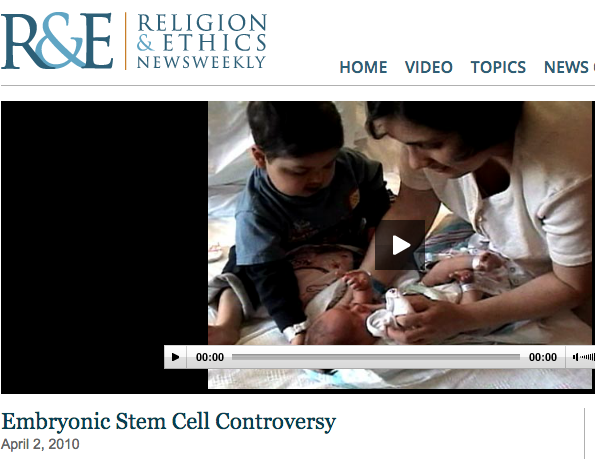Embryos, PGD, & Cybrids Video
Religion & Ethics Weekly. Embryonic Stem Cell Controversy. April 2, 2010. (7min) Link. A review of PGD and the creation of a savior siblings in the case of the Trevino family.
Resources
Since the discovery of human embryonic stem cells in 1998, policies have shifted with respect to permissible research and funding streams as quickly as the technologies advance. In the US, congressional legislation regarding public funding for stem cell research has been proposed and stalled, presidential executive orders shift with each new administration, and court injunctions have blocked entry into clinical practice. In the private sector, families continue to create saviour siblings to better the lives of those living with disability or disease and donate surplus embryos created through IVF to establish stem cell lines. The first video from Religion & Ethics Weekly highlights the case of one such family, the Trevinos who traversed a number of religious, ethical, social, and legal issues to address a genetic disorder affecting their child. In their case they approached the Vatican for advice, and the Trevino mother underwent five rounds of hormone stimulation and IVF to create 36 embryos that were then screened for a heritable genetic mutation and immunological match for her son. Using this combination of technologies (IVF and PGD), the family was successful in selecting an embryo that would develop into a sibling that serves as a source of stem cells for her brother living with the genetic disease, NEMO. By reading the comments section from the Trevino father’s blog, we learn that the savior sibling’s cord blood proved insufficient in stem cells, and so bone marrow was removed from her hip. The unused embryos were used by stem cell researcher George Daley to create stem cell lines for research. Jodi Picoult's book and the trailer of the film adaption My Sister's Keeper provides a quick view into the challenges of creating embryos for siblings in hopes of using stem cell therapy. The creation of such saviour siblings requires both genetic positive selection (HLA immunological matching) and negative genetic selection (selecting only embryos with the wildtype gene variant). The next three videos review the different interpretations of the Dickey Wicker Appropriations Rider by the Bush and the Obama Administrations, the Sherley v. Sebelius court case regarding these interpretations, and movement in Congress to institute policy on creating and using embryos in research that would hold across different presidential administrations. The fifth video is from the Lines that Divide documentary and presents differing views on stem cell research policy spanning those of stem cell researchers, pro-life advocates, women’s health advocates, and religious and philosophy scholars, and is available as a full length feature. Hope Deferred is a full-length documentary that takes it title from this quote in the King James Bible (Cambridge Ed.) “Hope deferred maketh the heart sick: but when the desire cometh, it is a tree of life.” The video from Arise America discusses the fate of unused frozen embryos, but only in the reproductive context, while the ethics committee statement from the American Society for Reproductive Medicine cautions against the use of abandoned embryos for stem cell research without acquiring proper informed consent. These positions stem from concerns regarding the moral status of the embryo. This issue is also taken up in the video that highlights the UK policy of allowing for the construction of animal-human embryos (cybrids), for research. Unlike the UK, this technique can not be used by researchers receiving federal funding in the US.
- Video: Religion & Ethics Weekly. Embryonic Stem Cell Controversy. April 2, 2010. (7min) Link. A review of PGD and the creation of a savior siblings in the case of the Trevino family.
- Film: My Sister's Keeper. 2009 (2:34 min) Link. and full movie available on YouTube.Link.
- Video: Rosary Films 2009. Stem Cell Research Policy of President Bush/ Adult Versus Embryonic Stem Cells. Youtube. Link
- Video: Anonymous. 2009. Politics: President Obama on Stem Cell Research. YouTube. Link
- Video: March 9, 2009. Rep DeGette on MSNBC’s Hardball with Chris Matthews (11:34 min) Link
- Video: Hafer, J. & Lahl, J. (Producers). Godawa, B. (Director). 2009. Lines that Divide: The Great Stem Cell Debate. Boulevard Pictures. Link includes 7 1-2 minute clips; (1:39 min) IMDB video clip. Link
- Video: Ellison, B. (Producer). 2009. “Hope Deferred.” Siegal, J. (Director) (2:24 min). Brooke Ellison Project. Link. The title of this film refers to the King James Bible (Cambridge Ed.) “Hope deferred maketh the heart sick: but when the desire cometh, it is a tree of life.”
- Video: Walsh, F. April 8, 2008. UK’s First Hybrid Embryos Created. BBC News. Text and Video Link, but video easily downloadable from Link
- Video: Arise America: Dr. John Zhang and Leftover Embryos.New Hope Fertility Center. YouTube (5:05 min) Link
- Committee Position Statement: Ethics Committee of the American Society for Reproductive Medicine. June 2013. Disposition of abandoned embryos: A committee opinion. Fertility and Sterility. 99 (7):1848-1849. Link, but video easily downloadable from Link
- News: Lewin, T. June 17, 2015. Industry’s Growth Leads to Leftover Embryos, and Painful Choices. New York Times. :A1. Link
- Research Article: Goedeke, S., et al. 2017. The fate of unused embryos. Qualitative Health Research. 27(10):1529-1540. Link





